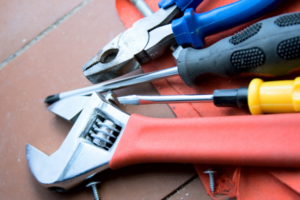 On this week’s episode of You Got This! Andrew discusses some plumbing truths and which tools of the trade every DIY plumber needs in their tool box. Not every job requires a professional, and having the right tools can set you up for success. So, what’s in your tool box? Oh, and the undeniable plumbers creed goes like this: Poop goes down hill, payday is on Friday and don’t bite your nails.
On this week’s episode of You Got This! Andrew discusses some plumbing truths and which tools of the trade every DIY plumber needs in their tool box. Not every job requires a professional, and having the right tools can set you up for success. So, what’s in your tool box? Oh, and the undeniable plumbers creed goes like this: Poop goes down hill, payday is on Friday and don’t bite your nails.
1. Propane Torch: Required if you’re going to sweat copper pipe and fittings. Spend the extra money for a self-igniting torch head ($30-$60) that lights at the squeeze of a trigger. You’ll find it much more convenient than using a striker or matches.
2. Tongue-and-Groove Pliers: Commonly called by the brand name Channel Locks, these pliers are the first tool plumbers reach for when they need to grab, pull, twist, hold, tighten or loosen something. Be sure to get two sizes: 10-in. ($10-$15) and 12-in. ($20-$25).
3. Hacksaw: Use this versatile saw ($15-$25) to cut through metal pipe, hardware, screws, nuts and bolts and plastic pipe. Make sure the blade is tense in the frame for tough cuts, and be sure to keep extra blades on hand. In tight spots, wrap one end of a loose blade in a cloth to create a handle to slip the blade in for the cut.
4. Metal File: This tool removes burrs and smooths the edges of metal pipes after cutting. It’s best to have two files on hand: half-round ($10), which has both rounded and flat surfaces, and a rat-tail file ($8), which is round and tapered.
5. Basin Wrench: An invaluable tool ($10-$20) for tightening and loosening nuts that hold sink faucets in place. The tool’s long shaft and swiveling jaw can reach up and into the deep, narrow space behind a sink and lock onto the nuts. There’s no other tool that can do what this one does.
6. Pipe Wrench: These large, heavy wrenches are used to tighten and loosen threaded pipes, fittings and nuts. You’ll need two–one for turning and one for gripping and holding. The serrated teeth help the wrench hold its grip but can damage a fixture’s finish–when you need protection, wrap the wrench’s jaws in a cloth. Buy a 10-in. ($10-15) and a 14-in. ($20-$25) model.
7. Hand Auger: Sometimes called a plumber’s snake, this hand-cranked drain-clearing tool ($20-$30) has a 25-ft.-long flexible steel cable that’s effective at clearing obstructions from tubs, showers, sinks, toilets and drain lines. Use it when the plunger (see below) fails to clear the clog.
8. Adjustable Wrench: This versatile tool is required for working on compression fittings, supply lines and other plumbing parts that have hex-shaped nuts. When shopping, check that the moving jaw holds a firm setting so that it won’t slip loose under torque. Again, it’s best to get two sizes: 6-in. ($10-$12) and 10-in. ($15-$20).
9. Tubing Cutter: Looking somewhat like a C-clamp, this essential tool provides the quickest, cleanest way to cut copper pipe. Get both a standard-size tubing cutter ($10-$15) and a close-quarter mini-cutter ($15-$20), which works in tight spaces.
10. Plunger: This indispensable tool ($5-$10) isn’t called the plumber’s best friend for nothing. It’s the first tool to grab when you need to dislodge clogs from sinks, tubs, toilets, showers and floor drains. When using it in a toilet, press down, create a firm seal around the drain, and pull upward. The idea is to vacuum the clog out, not push it deeper.
11. Closet Auger: A manual clog-clearing tool ($14-$40) that’s specifically designed for toilets. Its long steel cable is tough enough to grind through the most stubborn clogs.
12. Fire-Resistant Cloth: A thick, specially treated cloth ($15) that’s used to protect nearby combustible surfaces when soldering with an open-flame propane torch. It’s always smart to keep a fire extinguisher nearby, too.
